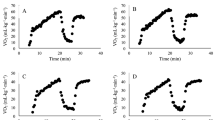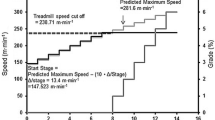Abstract
Introduction
Current methods (plateau/secondary criteria) to determine maximal oxygen consumption (\( {\dot{\text{V}}} \)O2max) are inconsistently achieved leading some to suggest the use of a verification phase (VP) to confirm \( {\dot{\text{V}}} \)O2max.
Purpose
To provide further evidence for the inclusion of a VP to confirm \( {\dot{\text{V}}} \)O2max in different fitness levels.
Methods
Forty-nine participants (22 females; 21.9 ± 2.6 years, 24.3 ± 2.8 kg m−2, 45.27 ± 7.68 mL kg−1 min−1) had their \( {\dot{\text{V}}} \)O2 and heart rate measured during three graded exercise tests (GXT) on separate days each followed by a VP of differing intensity (85%, 95%, 105% final workload). Participants were divided into groups using norms adapted from American College of Sports Medicine \( {\dot{\text{V}}} \)O2max guidelines (30.47–61.47 mL kg−1 min−1). \( {\dot{\text{V}}} \)O2max was confirmed if the \( {\dot{\text{V}}} \)O2peak on the VP or an additional GXT was within ± 2 × typical error of the \( {\dot{\text{V}}} \)O2peak attained on the first GXT. There was no effect of test number so the third GXT was not included in comparison with VP.
Results
The \( {\dot{\text{V}}} \)O2peak from the first GXT was not different than either value attained following the VP at 95 or 105% workload or a second GXT (p > 0.999). The 85% VP \( {\dot{\text{V}}} \)O2peak was lower than the first GXT \( {\dot{\text{V}}} \)O2peak (p = 0.002). The VP confirmed the GXT \( {\dot{\text{V}}} \)O2peak on 73% of VP (no differences among fitness levels). Submaximal VP (85 and 95%) was less effective as 65% and 51% of participants achieved a higher \( {\dot{\text{V}}} \)O2peak on one of the GXT.
Conclusion
The use of a VP at 105% or a second GXT was able to confirm the \( {\dot{\text{V}}} \)O2max value attained across a range of fitness levels.



Similar content being viewed by others
Abbreviations
- ACSM:
-
American College of Sports Medicine
- ANOVA:
-
Analysis of variance
- GXT:
-
Graded exercise test
- HR:
-
Heart rate
- HRmax :
-
Maximal heart rate
- RER:
-
Respiratory exchange ratio
- TE:
-
Typical error
- VP:
-
Verification phase
- VP85 :
-
Verification phase 85%
- VP95 :
-
Verification phase 95%
- VP105 :
-
Verification phase 105%
- \( {\dot{\text{V}}} \)CO2 :
-
Carbon dioxide production
- \( {\dot{\text{V}}} \)O2max :
-
Maximal oxygen consumption
- \( {\dot{\text{V}}} \)O2peak :
-
Peak oxygen consumption
- \( {\dot{\text{V}}} \)O2 :
-
Oxygen consumption
References
Astorino TA, Robergs RA, Ghiasvand F, Marks D, Burns S (2000) Incidence of the oxygen plateau at VO2max during exercise testing to volitional fatigue. J Exerc Physiol Online 3:1–12
Astorino TA, White AC, Dalleck LC (2009) Supramaximal testing to confirm attainment of VO2max in sedentary men and women. Int J Sports Med 30:279–284. https://doi.org/10.1055/s-0028-1104588
Astrand I (1960) Aerobic work capacity in men and women with special reference to age. Acta Physiol Scand Suppl 49:1–92
Azevedo P et al (2018) Commentaries on viewpoint: Vo2peak is an acceptable estimate of cardiorespiratory fitness but not Vo2max. J Appl Physiol 125:233–240. https://doi.org/10.1152/japplphysiol.00319.2018
Barker AR, Williams CA, Jones AM, Armstrong N (2011) Establishing maximal oxygen uptake in young people during a ramp cycle test to exhaustion. Br J Sports Med 45:498–503. https://doi.org/10.1136/bjsm.2009.063180
Dalleck LC, Astorino TA, Erickson RM, McCarthy CM, Beadell AA, Botten BH (2012) Suitability of verification testing to confirm attainment of VO(2)max in middle-aged and older adults. Res Sports Med 20:118–128. https://doi.org/10.1080/15438627.2012.660825
Day JR, Rossiter HB, Coats EM, Skasick A, Whipp BJ (2003) The maximally attainable VO2 during exercise in humans: the peak vs. maximum issue. J Appl Physiol 95:1901–1907. https://doi.org/10.1152/japplphysiol.00024.2003
Doherty M, Nobbs L, Noakes TD (2003) Low frequency of the “plateau phenomenon” during maximal exercise in elite British athletes. Eur J Appl Physiol 89:619–623. https://doi.org/10.1007/s00421-003-0845-z
Ferguson CJ (2009) An effect size primer: a guide for clinicians and researchers. Am Physiol Assoc 40:532–538
Glass S, Dwyer GB, ACSM (2007) ACSM metabolic calculation handbook. Lippincott Williams & Wilkins, Baltimore
Godin G, Shephard RJ (1997) Godin leisure-time exercise questionnaire. Med Sci Sports Exerc 26:S36–S38
Green S, Askew C (2018) Vo2peak is an acceptable estimate of cardiorespiratory fitness but not Vo2max. J Appl Physiol 125:229–232. https://doi.org/10.1152/japplphysiol.00850.2017
Gurd BJ et al (2016) Incidence of nonresponse and individual patterns of response following sprint interval training. Appl Physiol Nutr Metab 41:229–234. https://doi.org/10.1139/apnm-2015-0449
Hawkins MN, Raven PB, Snell PG, Stray-Gundersen J, Levine BD (2007) Maximal oxygen uptake as a parametric measure of cardiorespiratory capacity. Med Sci Sports Exerc 39:103–107. https://doi.org/10.1249/01.mss.0000241641.75101.64
Hill AV, Lupton H (1923) Muscular exercise, lactic acid, and the supply and utilization of oxygen. QJM 16:135–171
Hill DW, Poole DC, Smith JC (2002) The relationship between power and the time to achieve VO(2max). Med Sci Sports Exerc 34:709–714. https://doi.org/10.1097/00005768-200204000-00023
Hopkins WG (2000) Measures of reliability in sports medicine and science. Sports Med 30:1–15. https://doi.org/10.2165/00007256-200030010-00001
Issekutz B Jr, Rodahl K (1961) Respiratory quotient during exercise. J Appl Physiol 16:606–610. https://doi.org/10.1152/jappl.1961.16.4.606
Katch VL, Sady SS, Freedson P (1982) Biological variability in maximum aerobic power. Med Sci Sports Exerc 14:21–25
Kirkeberg JM, Dalleck LC, Kamphoff CS, Pettitt RW (2011) Validity of 3 protocols for verifying VO2 max. Int J Sports Med 32:266–270. https://doi.org/10.1055/s-0030-1269914
Kodama S et al (2009) Cardiorespiratory fitness as a quantitative predictor of all-cause mortality and cardiovascular events in healthy men and women: a meta-analysis. JAMA 301:2024–2035. https://doi.org/10.1001/jama.2009.681
Lucia A et al (2006) Frequency of the VO2max plateau phenomenon in world-class cyclists. Int J Sports Med 27:984–992. https://doi.org/10.1055/s-2006-923833
Midgley AW, Carroll S (2009) Emergence of the verification phase procedure for confirming “true” VO(2max). Scand J Med Sci Sports 19:313–322. https://doi.org/10.1111/j.1600-0838.2009.00898.x
Midgley AW, McNaughton LR, Carroll S (2006) Verification phase as a useful tool in the determination of the maximal oxygen uptake of distance runners. Appl Physiol Nutr Metab 31:541–548. https://doi.org/10.1139/h06-023
Midgley AW, McNaughton LR, Polman R, Marchant D (2007) Criteria for determination of maximal oxygen uptake: a brief critique and recommendations for future research. Sports Med 37:1019–1028. https://doi.org/10.2165/00007256-200737120-00002
Midgley AW, Carroll S, Marchant D, McNaughton LR, Siegler J (2009) Evaluation of true maximal oxygen uptake based on a novel set of standardized criteria. Appl Physiol Nutr Metab 34:115–123. https://doi.org/10.1139/H08-146
Murias JM, Pogliaghi S, Paterson DH (2018) Measurement of a true \( {\dot{\text{V}}} \)O2max during a ramp incremental test is not confirmed by a verification phase. Front Physiol 9:143. https://doi.org/10.3389/fphys.2018.00143
Niemela K, Palatsi I, Linnaluoto M, Takkunen J (1980) Criteria for maximum oxygen uptake in progressive bicycle tests. Eur J Appl Physiol Occup Physiol 44:51–59
Noakes TD (2008) Maximal oxygen uptake as a parametric measure of cardiorespiratory capacity: comment. Med Sci Sports Exerc 40:585. https://doi.org/10.1249/MSS.0b013e3181617350 (author reply 586)
Nolan PB, Beaven ML, Dalleck L (2014) Comparison of intensities and rest periods for VO2max verification testing procedures. Int J Sports Med 35:1024–1029. https://doi.org/10.1055/s-0034-1367065
Poole DC, Jones AM (2017) Measurement of the maximum oxygen uptake Vo2max: Vo2peak is no longer acceptable. J Appl Physiol 122:997–1002. https://doi.org/10.1152/japplphysiol.01063.2016
Poole DC, Wilkerson DP, Jones AM (2008) Validity of criteria for establishing maximal O2 uptake during ramp exercise tests. Eur J Appl Physiol 102:403–410. https://doi.org/10.1007/s00421-007-0596-3
Rossiter HB, Kowalchuk JM, Whipp BJ (2006) A test to establish maximum O2 uptake despite no plateau in the O2 uptake response to ramp incremental exercise. J Appl Physiol 100:764–770. https://doi.org/10.1152/japplphysiol.00932.2005
Sawyer BJ, Tucker WJ, Bhammar DM, Gaesser GA (2015) Using a verification test for determination of VO2max in sedentary adults with obesity. J Strength Cond Res 29:3432–3438. https://doi.org/10.1519/JSC.0000000000001199
Schaun GZ (2017) The maximal oxygen uptake verification phase: a light at the end of the tunnel? Sports Med Open 3:44. https://doi.org/10.1186/s40798-017-0112-1
Sedgeman D, Dalleck L, Clark IE, Jamnick N, Pettitt RW (2013) Analysis of square-wave bouts to verify VO2max. Int J Sports Med 34:1058–1062. https://doi.org/10.1055/s-0033-1341436
Taylor HL, Buskirk E, Henschel A (1955) Maximal oxygen intake as an objective measure of cardio-respiratory performance. J Appl Physiol 8:73–80. https://doi.org/10.1152/jappl.1955.8.1.73
Vinetti G et al (2019) Experimental validation of the 3-parameter critical power model in cycling. Eur J Appl Physiol 119:941–949. https://doi.org/10.1007/s00421-019-04083-z
Weatherwax RM, Richardson TB, Beltz NM, Nolan PB, Dalleck L (2016) Verification testing to confirm VO2max in altitude-residing, endurance-trained runners. Int J Sports Med 37:525–530. https://doi.org/10.1055/s-0035-1569346
Funding
No funding was required for this project. S. McCarthy was supported by a Canadian Institutes of Health Canada Graduate Scholarship (Masters).
Author information
Authors and Affiliations
Contributions
SFM and TJH conceived and designed research. SFM and JMPL conducted experiments. SFM, JMPL, and TJH analyzed data. SFM and TJH wrote the manuscript. All authors read and approved the manuscript.
Corresponding author
Ethics declarations
Conflict of interest
The authors declare that they have no conflict of interest to disclose.
Ethical approval
The experimental procedures were explained in detail to all participants and all provided written informed consent before any data collection. The Research Ethics Board at Wilfrid Laurier University approved this study in accordance with the ethical standards of the 1964 Declaration of Helsinki.
Additional information
Communicated by Guido Ferretti.
Publisher's Note
Springer Nature remains neutral with regard to jurisdictional claims in published maps and institutional affiliations.
Rights and permissions
About this article
Cite this article
McCarthy, S.F., Leung, J.M.P. & Hazell, T.J. Is a verification phase needed to determine \( {\dot{\text{V}}} \)O2max across fitness levels?. Eur J Appl Physiol 121, 861–870 (2021). https://doi.org/10.1007/s00421-020-04559-3
Received:
Accepted:
Published:
Issue Date:
DOI: https://doi.org/10.1007/s00421-020-04559-3




